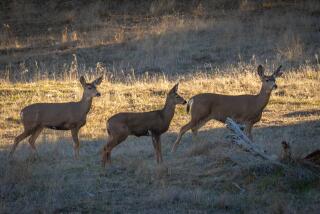Tough Sledding for Reindeer
- Share via
REDMOND, Ore. — Even Rudolph can’t help out in this jam.
A half-dozen reindeer herds that usually spend the Christmas season prancing in parades and around shopping malls have been grounded this year not by bad weather at the North Pole, but by government officials who fear the animals could spread chronic wasting disease.
Here at Operation Santa Claus, one of the nation’s largest reindeer herds, Cindy and Mike Gillaspie are keeping nearly all 90 of their animals home after they couldn’t get permits in 28 states to show their reindeer.
For the Gillaspies, idle reindeer are like idle factory space: Neither makes any money.
“I don’t know what we’re going to do,” said Cindy Gillaspie. “Maybe we’ll turn them all into sausage.”
Chronic wasting, a fatal illness attacking deer and elk, is caused by a mutant protein, or prion, that attacks brain tissue. Experts don’t know whether reindeer run the same infection risk as their cousins, but to be safe, most Central and Eastern states have banned out-of-state animals.
“Some states, like Virginia, had a complete lockdown and wouldn’t let people move animals even in their own state,” said Pat Lavery of Mayfield, N.Y., president of the 100-member Reindeer Owners and Breeders Assn. Virginia has since relented, he said, and local owners can display their animals but out-of-state herds are barred.
In some places, the ban threatens tradition. Officials at Uniontown Mall in Uniontown, Pa., learned in July that for the first time in 15 years their annual Christmas parade wouldn’t have its showpiece: Santa in a sleigh pulled by the Gillaspies’ reindeer.
And a Christmas parade without Santa in a sleigh doesn’t have much appeal.
“We had Santa come down a chimney instead,” said Debbie Julian, senior marketing director for the mall. “It was really tough to come up with something different.”
Nearly all the members of the reindeer owners group raise the animals for money, mostly renting them out for holiday shows and displays. The Gillaspies are among the few to have made the leap from hobby to full-time business, one of only a half-dozen herd owners who send their reindeer to other states.
The Gillaspies focus on the East Coast, Cindy Gillaspie said, because malls and other businesses there will pay three times as much -- up to $4,500 a day for four reindeer and a sleigh -- as their counterparts on the largely snow-less West Coast. Reindeer are a more integral part of Christmas traditions on the East Coast, she said, and on the West Coast animal-rights activists are more prevalent.
“On the West Coast, it’s more like, ‘Oh, those poor animals,’ ” Gillaspie said. “You don’t even want to go into Marin County.”
The Gillaspies took over as managers of Operation Santa Claus in 1984. Two years ago, they bought the business and 10-acre ranch on the outskirts of Redmond.
In April, Gillaspie said, every state she called about permits was allowing reindeer in. By June, the Plains states, from Montana to New Mexico, began closing. By September, the few became the many.
Gillaspie tracked the closures on a map that hangs over the desk in her home office, a small, overcrowded room off the ranch’s kitchen. Nearly 30 states are marked with round red stickers to signal closed borders. A half-dozen stickers also have black Xs, meaning chronic wasting had been found there.
“And those are just the ones I’ve called,” Gillaspie says.
Last year Operation Santa Claus took in about $250,000, not quite breaking even after the mortgage and business loans were factored in. Gillaspie had booked more than 60 shows for this season before the borders began closing. She canceled them all.
So this week, normally prime reindeer rental season, four of the Gillaspies’ reindeer were on display at the Los Angeles Zoo. Eight more were making the rounds of Christmas tree lots in Las Vegas with her husband. The rest were in the backyard.
Reindeer are friendly but occasionally aggressive animals, and Gillaspie has the scars to prove it. No. 908 -- the Gillaspies name their reindeer for shows but on the ranch identify them by number -- pinned Gillaspie against a fence, puncturing her arms with his antler points.
Gillaspie hopes the chronic wasting fears will subside over the winter and that she can start making arrangements in the spring for next winter’s shows. If not, she said, they’ll likely winnow the herd to 30 or so to cut back on feed bills that can run up to $1,300 a month.
Last week, the couple sold three reindeer that were made into sausage. More may go that route, she said, although she hopes to find other solutions. Except, maybe, for No. 908: “He’s our next sausage candidate.”
*
Times researcher Lynn Marshall contributed to this report.
More to Read
Sign up for Essential California
The most important California stories and recommendations in your inbox every morning.
You may occasionally receive promotional content from the Los Angeles Times.














